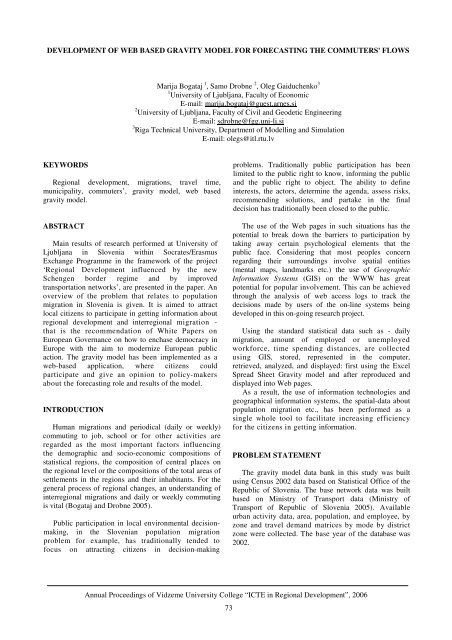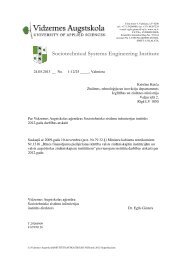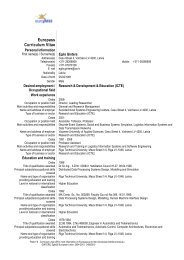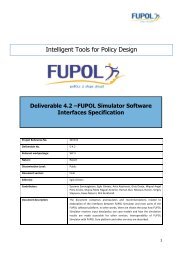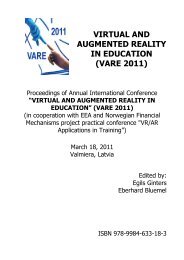ACKNOWLEDGEMENTThe paper results from a project jo<strong>in</strong>tly run by the Ottovon-GuerickeUniversity of Magdeburg (Germany) andthe Institute of Logistics and Warehous<strong>in</strong>g <strong>in</strong> Poznan(Poland) k<strong>in</strong>dly funded by DAAD under the ProjectbasedPersonnel Exchange Programme.REFERENCESKopanska, J. 2006. Evaluation of the “Introduction toECR” Learn<strong>in</strong>g Module. In: MSL – MagdeburgerSchriften zur Logistik 23.Lewandowska, J. 2005. Determ<strong>in</strong>ants and Instruments ofSupply Cha<strong>in</strong> Effectiveness Creation <strong>in</strong> the FMCGSector. Doctoral thesis, University of Economics,Poznań.Muntjewerff, A. J. and D. J. DeTombe. 2004. A GenericEnvironment for Integrat<strong>in</strong>g Stream<strong>in</strong>g Video <strong>in</strong> LegalEducation - e-See. In: <strong>Proceed<strong>in</strong>gs</strong> of ED-MEDIA 2004 –World Conference on Educational Multimedia andHypermedia; Lugano (Switzerland), June 21-26, 527-532.Neumann, G.; Krzyzaniak, S.; Lewandowska, J.; Boruta,M. 2006. E-Coach for Understand<strong>in</strong>g and Implement<strong>in</strong>gEfficient Consumer Response <strong>in</strong> Supply Cha<strong>in</strong>s. In: MSL– Magdeburger Schriften zur Logistik 23.Penn<strong>in</strong>g, S. and B. Karli. 2004. General Learn<strong>in</strong>gProgramme. Guid<strong>in</strong>g Pr<strong>in</strong>ciples. ECR Europe 2004.Strubelt, H. and G. Neumann. 2006. Requirements forKnowledge Management Support to Implement ECR <strong>in</strong>Practice. In: MSL – Magdeburger Schriften zur Logistik23.BIOGRAPHYGaby Neumann received a Diploma <strong>in</strong> MaterialsHandl<strong>in</strong>g Technology from the Otto-von-GuerickeUniversity of Technology <strong>in</strong> Magdeburg and a PhD <strong>in</strong>Logistics from the University of Magdeburg. S<strong>in</strong>ce 2003,she has been Junior Professor <strong>in</strong> Logistics KnowledgeManagement there. S<strong>in</strong>ce 1991, she has been alsowork<strong>in</strong>g as part-time consultant <strong>in</strong> logistics simulation.didactics of teach<strong>in</strong>g logistics as well as logisticscompetence profil<strong>in</strong>g and assessment.She has widely published <strong>in</strong> the field and has been or isbe<strong>in</strong>g <strong>in</strong>volved <strong>in</strong> a couple of respective projects. She isauthor/co-author of two books, one educationalmultimedia module on warehous<strong>in</strong>g and a series of e-learn<strong>in</strong>g modules <strong>in</strong> logistics as well as of 26 journalpublications and 61 papers and presentations at nationaland <strong>in</strong>ternational conferences. 10/2001, Best PaperAward: The International Workshop on Harbour,Maritime & Multimodal Logistics Modell<strong>in</strong>g andSimulation 2001; 01/2002, Award “ExcellentDissertation” by the Association of German Eng<strong>in</strong>eers.Dr. Neumann is member of the German Association ofEng<strong>in</strong>eers (VDI) and co-ord<strong>in</strong>ates the European logisticseducators network for provid<strong>in</strong>g new technologies forlogistics education <strong>in</strong>side the European LogisticsAssociation (ELA-LogNet).Stanislaw Krzyzaniak is Deputy Director at the Instituteof Logistics and Warehous<strong>in</strong>g <strong>in</strong> Poznan, responsible forscientific & research developments <strong>in</strong> the Institute. He isalso employed as an academic teacher <strong>in</strong> the PoznanSchool for Logistics.His ma<strong>in</strong> research <strong>in</strong>terest is modell<strong>in</strong>g and optimisationof <strong>in</strong>ventory management problems. He is author and coauthorof ca. 50 papers. He was also a speaker for manynational and <strong>in</strong>ternational conferences. He is experiencedtra<strong>in</strong>er <strong>in</strong> logistics, especially <strong>in</strong>ventory management; <strong>in</strong>this field, he developed an advanced tra<strong>in</strong><strong>in</strong>g module. Hewas a project manager or consultant for more than 15advisory projects on behalf of Polish companies.Dr Krzyzaniak organised and developed the PolishNational Certification System for logisticians <strong>in</strong> theECBL framework. He is a graduate <strong>in</strong> eng<strong>in</strong>eer<strong>in</strong>g fromPoznan University of Technology and holds a PhD <strong>in</strong>eng<strong>in</strong>eer<strong>in</strong>g. S<strong>in</strong>ce November 1999, he has been VicePresident of the Board of the Polish LogisticsAssociation (PTL)Furthermore, he is member of the Board of the EuropeanLogistics Association (ELA), Chairman of the Board ofthe European Certification Board for Logistics (ECBL)and its Scientific Committee, member of the Transport <strong>in</strong>Logistics Section of the Transport Committee of thePolish Academy of Science.Her current activities and research <strong>in</strong>terests are ma<strong>in</strong>lyl<strong>in</strong>ked to fields like problem solv<strong>in</strong>g and knowledgemanagement <strong>in</strong> logistics, logistics simulation andplann<strong>in</strong>g, and technology-based logistics learn<strong>in</strong>g,Annual <strong>Proceed<strong>in</strong>gs</strong> of Vidzeme University College “ICTE <strong>in</strong> Regional Development”, 200672
DEVELOPMENT OF WEB BASED GRAVITY MODEL FOR FORECASTING THE COMMUTERS' FLOWSMarija Bogataj 1 , Samo Drobne 2 , Oleg Gaiduchenko 31 University of Ljubljana, Faculty of EconomicE-mail: marija.bogataj@guest.arnes.si2 University of Ljubljana, Faculty of Civil and Geodetic Eng<strong>in</strong>eer<strong>in</strong>gE-mail: sdrobne@fgg.uni-lj.si3 Riga Technical University, Department of Modell<strong>in</strong>g and SimulationE-mail: olegs@itl.rtu.lvKEYWORDSRegional development, migrations, travel time,municipality, commuters’, gravity model, web basedgravity model.ABSTRACTMa<strong>in</strong> results of research performed at University ofLjubljana <strong>in</strong> Slovenia with<strong>in</strong> Socrates/ErasmusExchange Programme <strong>in</strong> the framework of the project‘Regional Development <strong>in</strong>fluenced by the newSchengen border regime and by improvedtransportation networks’, are presented <strong>in</strong> the paper. Anoverview of the problem that relates to populationmigration <strong>in</strong> Slovenia is given. It is aimed to attractlocal citizens to participate <strong>in</strong> gett<strong>in</strong>g <strong>in</strong><strong>format</strong>ion aboutregional development and <strong>in</strong>terregional migration -that is the recommendation of White Papers onEuropean Governance on how to enchase democracy <strong>in</strong>Europe with the aim to modernize European publicaction. The gravity model has been implemented as aweb-based application, where citizens couldparticipate and give an op<strong>in</strong>ion to policy-makersabout the forecast<strong>in</strong>g role and results of the model.INTRODUCTIONHuman migrations and periodical (daily or weekly)commut<strong>in</strong>g to job, school or for other activities areregarded as the most important factors <strong>in</strong>fluenc<strong>in</strong>gthe demographic and socio-economic compositions ofstatistical regions, the composition of central places onthe regional level or the compositions of the total areas ofsettlements <strong>in</strong> the regions and their <strong>in</strong>habitants. For thegeneral process of regional changes, an understand<strong>in</strong>g of<strong>in</strong>terregional migrations and daily or weekly commut<strong>in</strong>gis vital (Bogataj and Drobne 2005).Public participation <strong>in</strong> local environmental decisionmak<strong>in</strong>g,<strong>in</strong> the Slovenian population migrationproblem for example, has traditionally tended tofocus on attract<strong>in</strong>g citizens <strong>in</strong> decision-mak<strong>in</strong>gproblems. Traditionally public participation has beenlimited to the public right to know, <strong>in</strong>form<strong>in</strong>g the publicand the public right to object. The ability to def<strong>in</strong>e<strong>in</strong>terests, the actors, determ<strong>in</strong>e the agenda, assess risks,recommend<strong>in</strong>g solutions, and partake <strong>in</strong> the f<strong>in</strong>aldecision has traditionally been closed to the public.The use of the Web pages <strong>in</strong> such situations has thepotential to break down the barriers to participation bytak<strong>in</strong>g away certa<strong>in</strong> psychological elements that thepublic face. Consider<strong>in</strong>g that most peoples concernregard<strong>in</strong>g their surround<strong>in</strong>gs <strong>in</strong>volve spatial entities(mental maps, landmarks etc.) the use of GeographicIn<strong>format</strong>ion <strong>Systems</strong> (GIS) on the WWW has greatpotential for popular <strong>in</strong>volvement. This can be achievedthrough the analysis of web access logs to track thedecisions made by users of the on-l<strong>in</strong>e systems be<strong>in</strong>gdeveloped <strong>in</strong> this on-go<strong>in</strong>g research project.Us<strong>in</strong>g the standard statistical data such as - dailymigration, amount of employed or unemployedworkforce, time spend<strong>in</strong>g distances, are collectedus<strong>in</strong>g GIS, stored, represented <strong>in</strong> the computer,retrieved, analyzed, and displayed: first us<strong>in</strong>g the ExcelSpread Sheet Gravity model and after reproduced anddisplayed <strong>in</strong>to Web pages.As a result, the use of <strong>in</strong><strong>format</strong>ion technologies andgeographical <strong>in</strong><strong>format</strong>ion systems, the spatial-data aboutpopulation migration etc., has been performed as as<strong>in</strong>gle whole tool to facilitate <strong>in</strong>creas<strong>in</strong>g efficiencyfor the citizens <strong>in</strong> gett<strong>in</strong>g <strong>in</strong><strong>format</strong>ion.PROBLEM STATEMENTThe gravity model data bank <strong>in</strong> this study was builtus<strong>in</strong>g Census 2002 data based on Statistical Office of theRepublic of Slovenia. The base network data was builtbased on M<strong>in</strong>istry of Transport data (M<strong>in</strong>istry ofTransport of Republic of Slovenia 2005). Availableurban activity data, area, population, and employee, byzone and travel demand matrices by mode by districtzone were collected. The base year of the database was2002.Annual <strong>Proceed<strong>in</strong>gs</strong> of Vidzeme University College “ICTE <strong>in</strong> Regional Development”, 200673
- Page 1 and 2:
ISBN 9984-633-03-9Annual Proceeding
- Page 3 and 4:
“Development of Creative Human -
- Page 5 and 6:
TABLE OF CONTENTSINTELLIGENT SYSTEM
- Page 7 and 8:
INTELLIGENT SYSTEM FOR LEARNERS’
- Page 9 and 10:
LEARNER 1GROUP OF HUMAN AGENTSLEARN
- Page 11 and 12:
QuantityQuantityFigure 6. Distribut
- Page 13 and 14:
LEARNERStructure of theconcept mapL
- Page 15 and 16:
WEB-BASED INTELLIGENT TUTORING SYST
- Page 17 and 18:
materials to be presented and which
- Page 19 and 20:
INFORMATION TECHNOLOGIES AND E-LEAR
- Page 21 and 22:
correspondence with the course aim
- Page 23 and 24:
projects and through IT. Hence, it
- Page 25 and 26:
APPLICATION OF MODELING METHODS IN
- Page 27 and 28: can support configuration managemen
- Page 29 and 30: The EKD is one of the Enterprise mo
- Page 31 and 32: CHANGES TO TRAINING AND PERSPECTIVE
- Page 33 and 34: or an end, yet none of these attitu
- Page 35 and 36: make decisions. It cannot be volunt
- Page 37 and 38: logs), data and video conferencing
- Page 39 and 40: Ability to follow user’s multi-ta
- Page 41 and 42: CONCLUSIONSEDUSA method gives us a
- Page 43 and 44: in successful SD. Given this situat
- Page 45 and 46: SPATIAL INFORMATIONFor the visualis
- Page 47 and 48: MOBILE TECHNOLOGIES USE IN SERVICES
- Page 49 and 50: learning environment (Learning Mana
- Page 51 and 52: ago only some curricula on Logistic
- Page 53 and 54: The Web-based version can be access
- Page 55 and 56: Web-portal, which incorporates diff
- Page 57 and 58: DO INTELLIGENT OBJECTS AUTOMATICALL
- Page 59 and 60: Table 1. Examples for introducing R
- Page 61 and 62: workable influencing of the process
- Page 63 and 64: are handed over to the objects and
- Page 65 and 66: • Basic processes, such as wareho
- Page 67 and 68: THE ECR E-COACH: A VIRTUAL COACHING
- Page 69 and 70: participating in the workshops and
- Page 71 and 72: • Assessment modules enable indiv
- Page 73 and 74: with pictures and illustrated graph
- Page 75 and 76: ECR Question Banknumber category su
- Page 77: educational programme that follows
- Page 81 and 82: These results of a model require a
- Page 83 and 84: CONCLUSIONSThe main goal of work ha
- Page 85 and 86: dimension and included within any o
- Page 87 and 88: • Resources sharing by providing
- Page 89 and 90: Pursuant to the guidelines of elect
- Page 91 and 92: tariffs of regulated services have
- Page 93 and 94: INFORMATION TECHNOLOGY FOR MOTIVATI
- Page 95 and 96: difficult to predict when and for w
- Page 97 and 98: Listeners' workon the WebListenersS
- Page 99 and 100: PERSPECTIVES OF WEB PAGE AND E-MAIL
- Page 101 and 102: INCREASE IN THE NUMBER OF INTERNETU
- Page 103 and 104: tourism accommodations (home pages
- Page 105 and 106: interactive relationships with clie
- Page 107 and 108: • The data obtained by the resear
- Page 109 and 110: Central Statistical Bureau of Latvi
- Page 111 and 112: departures for 1995 are taken from
- Page 113 and 114: 120100maximumworldminimum806040200-
- Page 115 and 116: 140120maximumworldminimum1008060402
- Page 117 and 118: would be a promising extension. Cur
- Page 119 and 120: AN OVERVIEW OF THE AGENT − BASED
- Page 121 and 122: Suitability for social system simul
- Page 123 and 124: 6. MASONDescription:MASON is a fast
- Page 125 and 126: Suitability for social system simul
- Page 127 and 128: could be bad particularly when over
- Page 129 and 130:
(for 10 repeat &| CCar[]->runfor);P
- Page 131 and 132:
• Streaming audio• Collaboratio
- Page 133 and 134:
NECESSITY OF NEW LAYERED APPROACH T
- Page 135 and 136:
Up to now, there has only been limi
- Page 137 and 138:
aaaaa6= −aa2,1 = − a0,3226= −
- Page 139 and 140:
∂ u∂x∂ u∂y2 2+ b = 02 2wher
- Page 141 and 142:
a6,3= −2030a4,5−130a4,3- - - -
- Page 143 and 144:
0,10,20,30,4( )Mag x y y Ge wx2, =
- Page 145 and 146:
Example 1. To understand better the
- Page 147 and 148:
Therefore, further the following co
- Page 149 and 150:
SOLUTION OF THE THREE-DIMENSIONALEQ
- Page 151 and 152:
Mag1, m , m , m1 2 3= mm1 m2m32 2 2
- Page 153 and 154:
MagMag0, m , m , m1 2 31, m , m , m
- Page 155:
CONCLUSIONSThe basic content of thi


